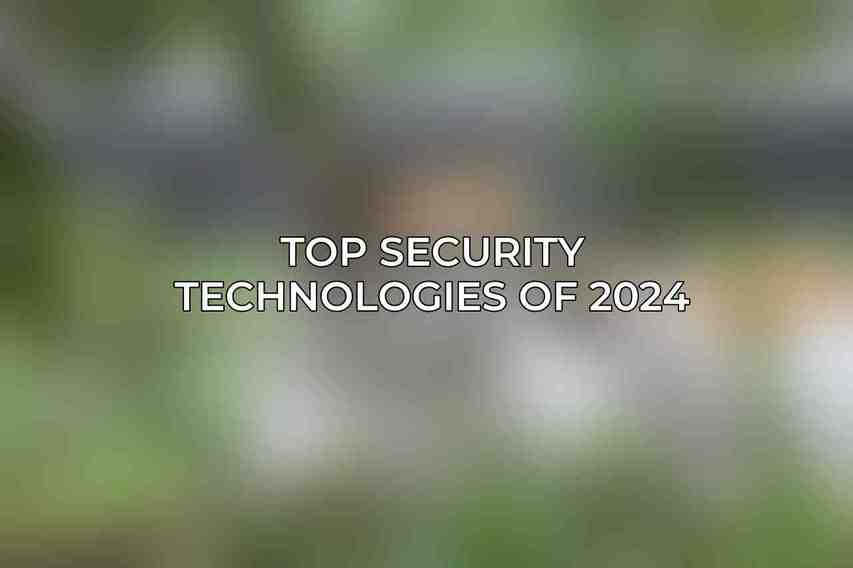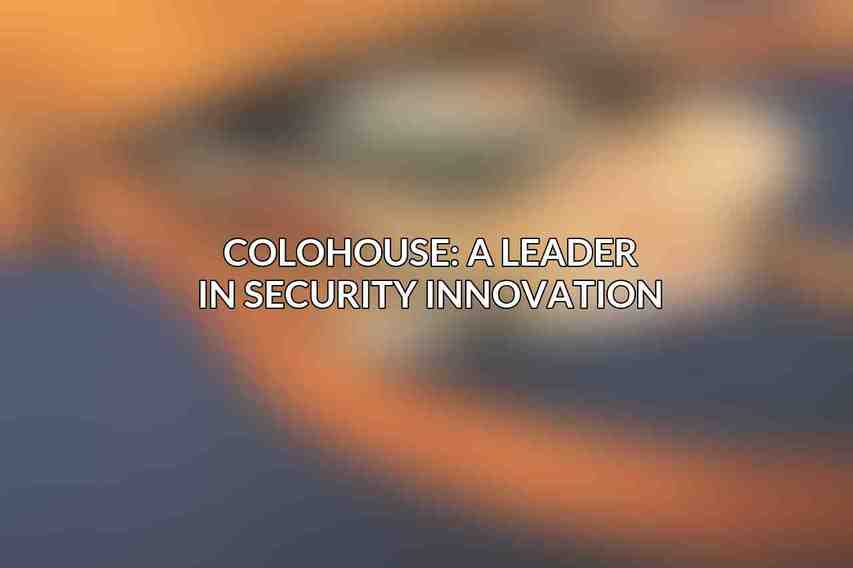In 2024, the cybersecurity world continues to evolve rapidly, with increasingly sophisticated threats targeting individuals, businesses, and governments worldwide. As digital transformation accelerates across industries, the need for robust security measures has never been more critical. Cyber attacks are becoming more frequent and complex, making it essential for organizations to stay ahead of potential threats.
Implementing advanced security technologies is imperative to protect sensitive data and safeguard infrastructure from malicious actors. By staying informed and adopting the latest security solutions, businesses can mitigate risks and ensure the confidentiality, integrity, and availability of their information assets.
| Feature | Description | Link | |||||||||||||||||||||||||||||||||||||||||||||||||||||||||||||||||||||||||||||||||||||||||||||||||
|---|---|---|---|---|---|---|---|---|---|---|---|---|---|---|---|---|---|---|---|---|---|---|---|---|---|---|---|---|---|---|---|---|---|---|---|---|---|---|---|---|---|---|---|---|---|---|---|---|---|---|---|---|---|---|---|---|---|---|---|---|---|---|---|---|---|---|---|---|---|---|---|---|---|---|---|---|---|---|---|---|---|---|---|---|---|---|---|---|---|---|---|---|---|---|---|---|---|---|---|
| Security Certifications | Compliance with industry-leading security standards, including ISO 27001, PCI DSS, and HIPAA | Link | |||||||||||||||||||||||||||||||||||||||||||||||||||||||||||||||||||||||||||||||||||||||||||||||||
| Physical Security | Multi-layered physical security measures, including biometric access control, 24/7 surveillance, and armed guards | Link | |||||||||||||||||||||||||||||||||||||||||||||||||||||||||||||||||||||||||||||||||||||||||||||||||
| Cybersecurity Monitoring | Advanced threat detection and response systems, including intrusion detection, malware analysis, and log monitoring | Link | |||||||||||||||||||||||||||||||||||||||||||||||||||||||||||||||||||||||||||||||||||||||||||||||||
| Network Security | Robust network security measures, including firewalls, DDoS protection, and intrusion prevention systems | Link | |||||||||||||||||||||||||||||||||||||||||||||||||||||||||||||||||||||||||||||||||||||||||||||||||
| Data Backup and Recovery | Comprehensive data backup and recovery solutions to protect critical data from loss or corruption | Link | |||||||||||||||||||||||||||||||||||||||||||||||||||||||||||||||||||||||||||||||||||||||||||||||||
| Disaster Recovery | Proven disaster recovery plans and procedures to ensure business continuity in the event of a disaster | Link | |||||||||||||||||||||||||||||||||||||||||||||||||||||||||||||||||||||||||||||||||||||||||||||||||
| Visit Colohouse | |||||||||||||||||||||||||||||||||||||||||||||||||||||||||||||||||||||||||||||||||||||||||||||||||||
Top Security Technologies of 2024

A. Zero-Trust Architecture (ZTA)
Zero-Trust Architecture (ZTA) is a cybersecurity model based on the principle of “never trust, always verify.” This approach assumes that threats could be both external and internal, requiring strict identity verification and continuous monitoring to prevent breaches. By leveraging ZTA, organizations can enhance their security posture by implementing strict access controls, least privilege access, and network segmentation.
Benefits of implementing ZTA include:
Enhanced Security: By assuming that every user and device is potentially compromised, ZTA minimizes the risk of lateral movement by threat actors within the network.
Improved Compliance: ZTA aligns with regulatory requirements by enforcing strict access controls and auditing capabilities to track user activities.
B. Extended Detection and Response (XDR)
Extended Detection and Response (XDR) is a comprehensive security solution that integrates multiple security components like endpoint detection and response, network security, and threat intelligence into a unified platform. XDR enables organizations to correlate security events across different layers of their infrastructure, providing a holistic view of potential threats.
XDR enhances threat detection and response by:
Increasing Visibility: By consolidating security alerts from various sources, XDR offers a centralized view of the organization’s security posture, enabling faster incident response.
Automation: XDR leverages automation and machine learning to prioritize alerts, streamline investigations, and respond to threats proactively.
C. Artificial Intelligence (AI) in Cybersecurity
Artificial Intelligence (AI) plays a crucial role in cybersecurity by analyzing vast amounts of data to identify patterns, detect anomalies, and predict potential threats. AI-powered solutions are used in threat detection, prevention, and remediation processes, helping organizations stay ahead of adversaries in the cybersecurity world.
Applications of AI in cybersecurity include:
Threat Hunting: AI algorithms can proactively search for indicators of compromise, helping security teams identify and mitigate threats faster.
Behavioral Analysis: AI can analyze user and device behavior to detect unusual activities that may indicate a security breach.
D. Blockchain for Data Security
Blockchain technology offers a decentralized and tamper-evident way to store data, making it ideal for ensuring the integrity and security of transactions. By distributing data across a network of nodes and using cryptographic techniques to secure information, blockchain provides a transparent and secure platform for storing sensitive data.
Advantages of using blockchain in data security include:
Immutability: Once data is recorded on the blockchain, it cannot be altered or deleted, ensuring the integrity of records.
Transparency: Blockchain enables all parties to verify the authenticity of transactions, promoting trust and reducing the risk of fraud.
Colohouse: A Leader in Security Innovation

A. Introduction to Colohouse and its Data Center Services
Colohouse is a renowned provider of data center and connectivity solutions, offering state-of-the-art facilities designed to meet the demanding needs of modern businesses. With a focus on reliability, performance, and security, Colohouse delivers a range of colocation and cloud services to support organizations of all sizes.
B. Colohouse’s Commitment to Security
Colohouse prioritizes security through:
Industry Certifications: Colohouse adheres to industry best practices and holds certifications such as SOC 2 and HIPAA compliance to ensure the security and privacy of customer data.
Physical Security Measures: The data centers are equipped with biometric access control, 24/7 surveillance, and stringent security protocols to protect against unauthorized access.
C. Colohouse’s Advanced Security Solutions
Colohouse offers a suite of security services, including:
Cloud-Based Security: Services such as DDoS mitigation, intrusion detection, and firewall management help customers defend against online threats and cyber attacks.
Managed Security Services: Colohouse provides round-the-clock threat monitoring, incident response, and vulnerability management to enhance the security posture of businesses.
Colocation Options: For organizations requiring on-premises security infrastructure, Colohouse offers colocation services with tailored security configurations.
Case Studies: Success Stories with Colohouse

By partnering with Colohouse, organizations have achieved significant security improvements, including:
Reduced Downtime: Colohouse’s robust security solutions have helped organizations mitigate downtime due to cyber incidents, ensuring continuous operations.
Improved Compliance: Companies leveraging Colohouse’s services have enhanced their regulatory compliance and data protection efforts, meeting industry standards effectively.
Colohouse’s role in enhancing the security posture of these organizations has been instrumental in safeguarding their critical assets and maintaining business continuity.
the top security technologies of 2024, including Zero-Trust Architecture, Extended Detection and Response, Artificial Intelligence, and Blockchain, offer powerful tools to combat evolving cyber threats. It is essential for organizations to adopt these technologies to stay resilient against modern security challenges and protect their digital assets.
As a trusted partner in security innovation, Colohouse stands out for its commitment to providing advanced security solutions, industry-leading practices, and reliable data center services. By collaborating with Colohouse, organizations can enhance their security posture and navigate the complex cybersecurity world with confidence.
Frequently Asked Questions
What are the top security technologies of 2024?
The top security technologies of 2024 include AI-driven threat detection, zero trust security models, blockchain for secure data storage, endpoint detection and response (EDR) tools, and cloud security solutions.
What makes Colohouse stand out in the field of security technologies?
Colohouse stands out in the field of security technologies due to its advanced data encryption methods, state-of-the-art physical security measures at its data centers, 24/7 security monitoring, and robust disaster recovery plans.
How do AI-driven threat detection systems work?
AI-driven threat detection systems work by using machine learning algorithms to analyze patterns in network traffic and identify abnormal behavior that could indicate a potential security threat.
Why is zero trust security becoming increasingly important in this cybersecurity world?
Zero trust security is becoming increasingly important in this cybersecurity world because traditional perimeter-based security measures are no longer sufficient to protect against sophisticated cyber attacks. Zero trust security assumes that every user and device on the network is a potential threat and requires strict authentication and authorization controls.
How can blockchain technology enhance data security in 2024?
Blockchain technology can enhance data security in 2024 by providing a tamper-proof and decentralized platform for storing sensitive information. By using blockchain for secure data storage, organizations can ensure data integrity and prevent unauthorized access to their data.

